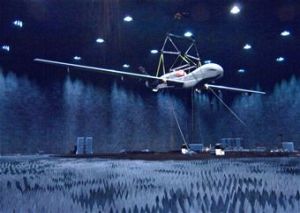Electromagnetic interference (EMI) testing on the European version of Northrop Grumman’s Global Hawk– the Euro Hawk – was performed recently by engineers with the 772nd Test Squadron at the Benefield Anechoic facility (BAF) at Edwards Air Force Base, California.
Northrop Grumman and German government representatives participated as well. Although EMI testing already has been conducted on the Global Hawk UAV, the Euro Hawk has never been flown in the unique radio frequency environment of Europe, Air Force officials say.
“There are radars and radio stations. Our civilization is filled with electromagnetic sources,” says Daniel Suh, NGC Euro Hawk System engineering manager. “In highly populated areas there are more emitters so there’s risk associated in flying an unmanned aircraft in those environments. The BAF provided some unique testing to reduce that risk.”
Because of the BAF’s design, it enables testers to evaluate the aircraft’s radio emissions and absorptions in an environment that is sanitized of outside radio frequencies. This prevents those sources from interfering and compromising the tests.
Suh says interference could have an effect on the avionics of any aircraft with electronic equipment. Communications and navigation systems are a few examples of electronic equipment that could potentially face detrimental EMI effects, including failure.
The BAF is capable of simulating different electromagnetic interference and Maj. Corey Beaverson, the 772nd TS operations director, says the test team subjected the Euro Hawk to EMI environments they believe the aircraft will encounter in Europe.
“We know there are certain environments that the Euro Hawk is going to be subjected to across the ocean and while operating in its intended role,” Beaverson says. “Are those environments going to be safe from an electromagnetic interference and compatibility perspective? Partnering with the Global Vigilance Combined Test Force, Northrop Grumman and our German allies, we’ve developed a series of tests to see how the aircraft reacts to some known electromagnetic fields.
“What the BAF is doing is providing a clean (radio frequency) environment and we are subjecting the Euro Hawk to electric fields at a variety of frequencies that are representative of what we understand the electromagnetic environment to be in Europe,” he continues.”We adjusted different frequency ranges,” Suh says. “There are specific frequencies that we look at using the antennas within the BAF, as well as adjusting energy levels.”
The Euro Hawk is an unmanned aircraft that has been authorized by U.S. officials for direct commercial sales to representatives of allied countries. Suh says German Ministry of Defence officials specifically wanted the Euro Hawk tested at the BAF because of the facility’s unique capabilities. This is one part of the Euro Hawk’s comprehensive testing at Edwards AFB that has been a collaborative effort between the U.S. military, private industry, and a foreign ally, Air Force officials say.
“I think it’s a great team,” Suh says. “We rolled into the BAF at the end of January. Previously, we coordinated with the Combined Test Force as well as Wright-Patterson Air Force Base, (Ohio), in going through our detailed test plan … making sure our test objectives were achievable before coming to the BAF. It’s been a great experience.”
The Euro Hawk has been undergoing flight testing at Edwards AFB since last year and is expected to complete its visit to the high desert during the summer.
Source: Military Aerospace

